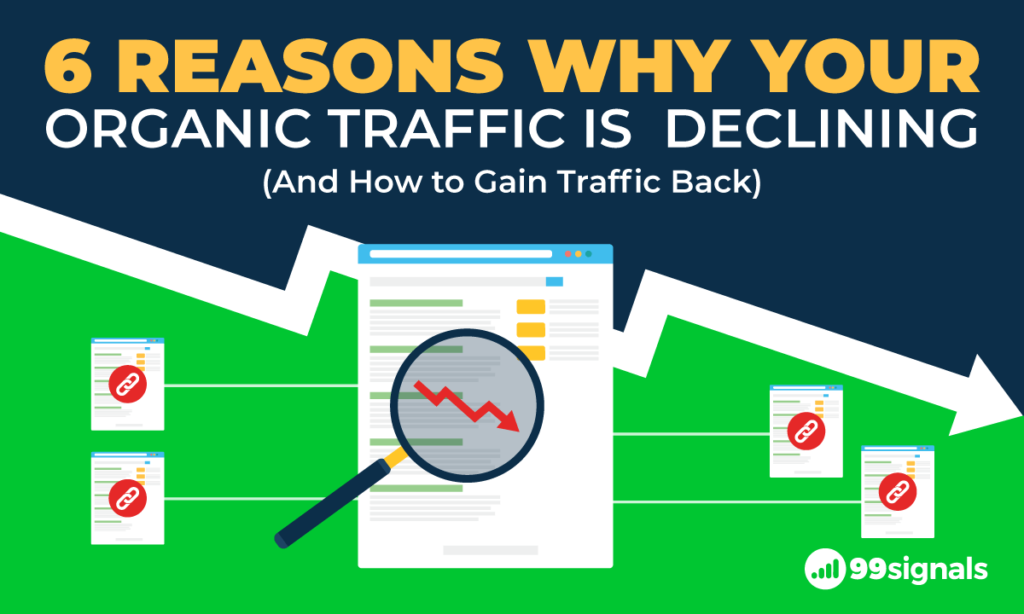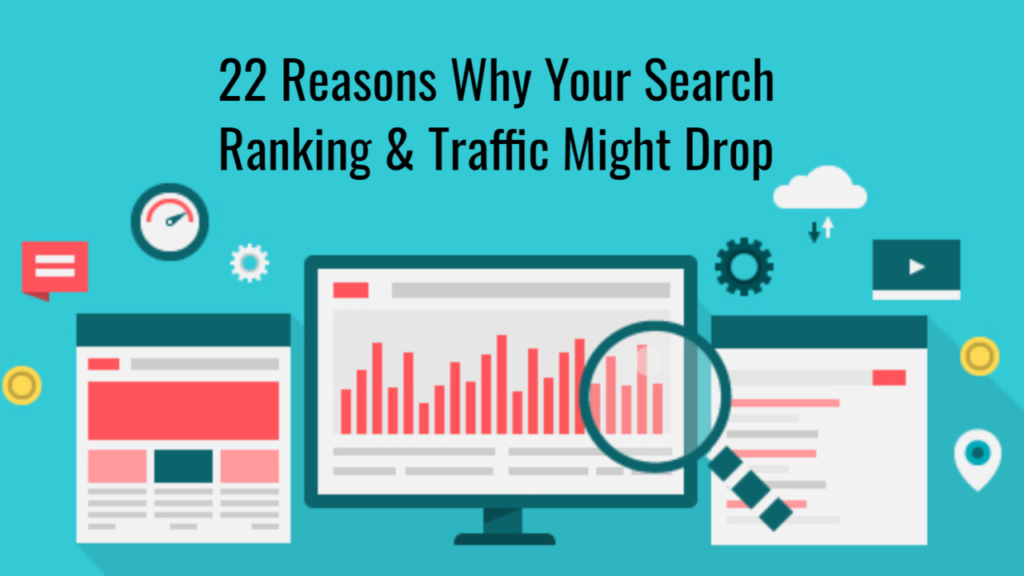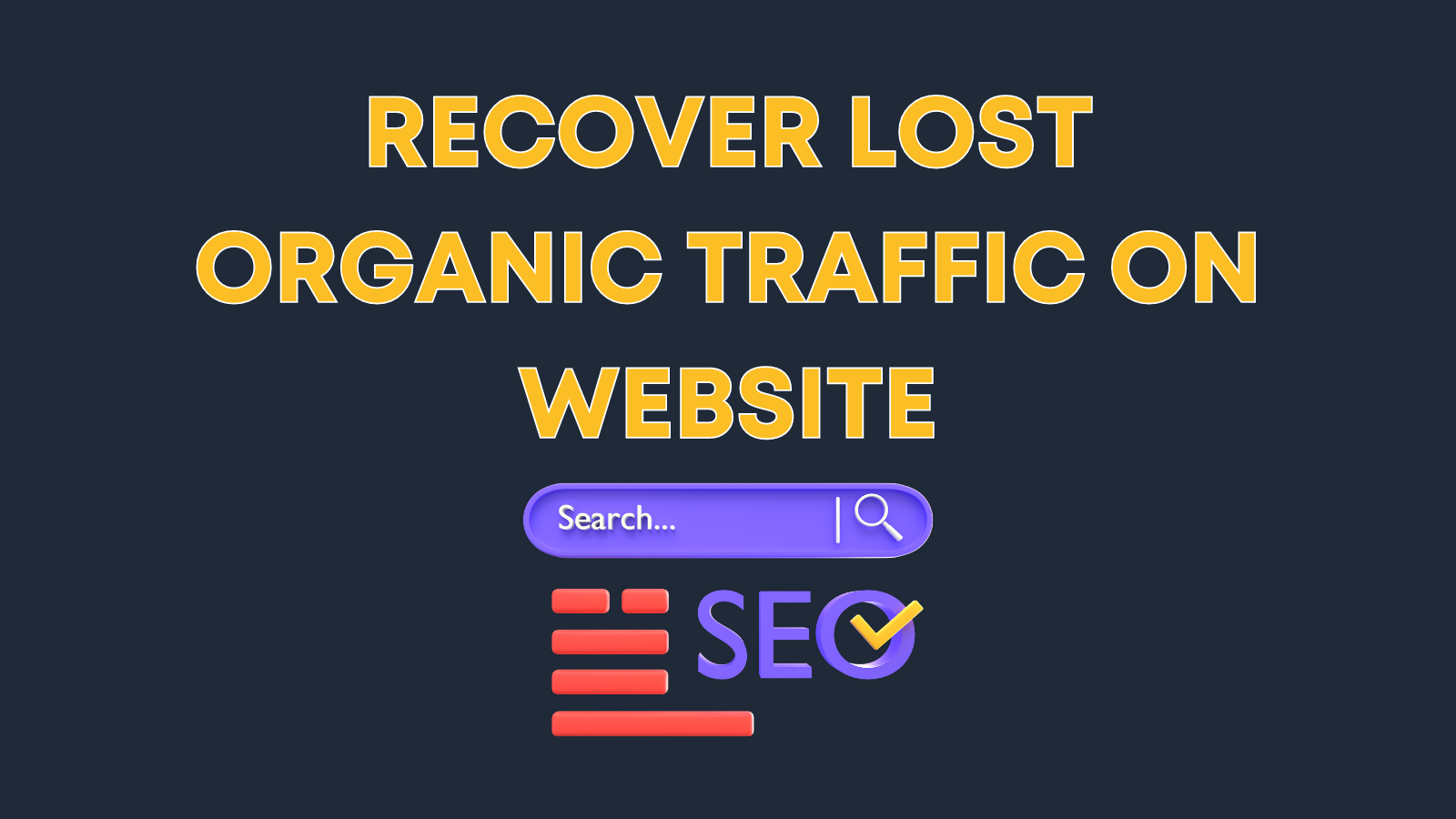Navigating through a sudden drop in organic traffic can be quite unsettling. Even the most meticulous website owners encounter such situations. At Forge and Smith, we’ve experienced two significant organic traffic drops in the past eight years, so we understand the frustration.
While it’s tempting to jump to conclusions and assume a Google penalty, such occurrences are relatively rare and usually reserved for egregious violations of SEO guidelines. So, before panicking, it’s essential to take a step back and assess the situation.
If you’ve noticed a sharp decline in organic traffic on Google Analytics, it’s crucial to identify the root cause behind it. In this guide, we’ll delve into the primary reasons for an organic traffic drop and offer actionable solutions to help you regain traction and boost your organic search presence.
Reasons Behind a Drop in Organic Search Traffic:

- Impact of Google’s Broad Core Algorithm Update: Your content might have been adversely affected due to changes in Google’s algorithm, often linked to factors like quality, speed, or trustworthiness.
- Deletion of High-Traffic Content: Removing a piece of content that previously generated significant organic search traffic can result in a decline.
- Significant Site Changes: Altering your site structure or a large portion of its content, such as through a redesign or content overhaul, can lead to fluctuations in organic traffic.
- Technical SEO Issues Post-Migration or Relaunch: Errors during domain migration or website relaunches may cause technical SEO issues that impact organic traffic.
- Tracking Code Alterations or Technical Bugs: Changes to Google Analytics tracking code or technical glitches with Google tools can disrupt proper traffic tracking.
- Technical Site Problems: Technical issues, like server problems, can prevent organic traffic from reaching your site.
- Seasonal or Timely Content Trends: Changes in seasonal or timely content relevance can affect organic traffic patterns.
- Competitor Outranking: Competitors surpassing your site in search rankings for high-traffic keywords can diminish your organic traffic.
- Blocked Indexed Content: Blocking content that was previously indexed can lead to a drop in organic traffic.
- Google Manual Action or Penalty: Google may issue a manual action or penalty for violations of its terms, resulting in decreased organic traffic.
Honorary 11th Reason: Loss of High-Authority Backlinks: Losing backlinks from authoritative sites can reduce your site’s relevance and authority, indirectly impacting organic traffic due to lower search rankings.
Understanding these potential factors can help pinpoint the cause of a drop in organic search traffic and inform effective strategies for recovery.
12 Steps to Identify and Address a Decline in Traffic:

- Conduct a Website Check: Ensure your hosting, server, security, and uptime are all functioning properly. Address any technical issues promptly.
- Review Google Search Console: Look for notifications regarding technical SEO warnings, indexing problems, server errors, usability issues, or manual actions. Seek guidance on resolving identified issues.
- Analyze Google Analytics: Verify that Google Analytics is accurately tracking traffic, particularly from organic search. Utilize the Realtime report to confirm website visits from organic search results.
- Monitor Google Algorithm Updates: Stay informed about recent Google algorithm updates and their focus areas, such as content quality, page speed, backlinks, or trustworthiness. Adapt your content or website accordingly.
- Investigate Google Bugs: Research if Google Search Console or Google Analytics is experiencing any known bugs affecting tracking or reporting. Stay updated on community feedback regarding potential issues.
- Check for Website Changes: Assess recent modifications to your website, including content updates, redesigns, or migrations, which may impact organic traffic.
- Evaluate Content Quality: Review the quality and relevance of your website content to ensure it aligns with user intent and satisfies search engine criteria.
- Assess Backlink Profile: Analyze your backlink profile to identify any changes or issues that may affect your site’s authority and search rankings. Address low-quality or spammy backlinks.
- Examine Website Speed and Performance: Evaluate your website’s speed and performance, addressing any issues that may contribute to a poor user experience and decreased search visibility.
- Review Competitor Activity: Monitor your competitors’ online presence and search rankings to identify potential factors influencing your organic traffic decline.
- Consult with SEO Experts: Seek advice from experienced SEO professionals or agencies to gain insights and recommendations for improving your website’s organic search performance.
- Implement Corrective Measures: Based on your analysis and recommendations, implement necessary fixes and optimizations to address identified issues and improve your website’s organic traffic.
- Utilize Google Trends Google Trends offers valuable insights into the fluctuating interests of your audience. By tracking the popularity of relevant topics, you can discern if there’s been a decline in interest that might affect your website traffic. It’s particularly helpful to cross-reference keywords driving traffic to your site with Google Trends data. This allows you to identify any shifts in search behavior and adjust your content strategy accordingly.
- Harness SEO Tools Tools like SEMRush or Ahrefs provide comprehensive keyword analysis, including changes in keyword rankings over time. By sorting keywords by rank difference, you can pinpoint any significant drops in ranking for crucial keywords related to your products or services. This helps you diagnose potential issues, such as content alterations or technical errors, that might be impacting your organic traffic.
- For instance, if a high-traffic keyword like “website design company” drops from page one to page two or lower, it warrants investigation, as it could lead to a noticeable decline in organic traffic. Analyzing which URL was ranking for the keyword can reveal if recent changes inadvertently affected your site’s visibility.
- Conduct Manual Searches In the absence of SEO tools, performing manual searches for your products or services allows you to gauge your website’s ranking on search engine results pages (SERPs). If you observe a drop in ranking, especially from the top three positions, it could significantly impact your organic traffic. Competitor advancements or algorithm updates may be influencing your ranking position, underscoring the importance of staying vigilant and adapting your SEO strategy accordingly.
- Assess Deleted Content Reviewing any deleted content that previously attracted organic traffic is crucial. Consider whether proper redirection was implemented for removed pages and evaluate the impact on user experience. While deleting irrelevant content can enhance site usability, it’s essential to weigh the potential loss of organic traffic against the overall improvement in content quality. Utilizing tools like Google Analytics to analyze the popularity of landing pages among organic traffic segments can provide valuable insights for decision-making.
- Top of Form
Top of Form
Top of Form
- Evaluate Significant Website Modifications Website updates are essential for adapting to evolving business needs and maintaining relevance in the digital landscape. However, it’s crucial to recognize that major changes to your site can impact organic traffic significantly. When Google’s crawlers revisit your site post-update, they encounter a shifted landscape, potentially leading to fluctuations in search engine rankings.
Common content-related factors contributing to a traffic drop include:

- Substantial edits to content on high-ranking, high-traffic pages
- Alterations across numerous pages
- Deletion of substantial amounts of content
- Modifications to site structure, such as content hierarchy and navigation
- Changes in location or contact details
These transformations often accompany a comprehensive website redesign and can initially result in a decline in traffic. Implementing thorough SEO strategies during and after the redesign process helps mitigate the impact, as Google reassesses the relevance and quality of your content.
Consider the example below, illustrating an organic traffic decline following a site overhaul and restructuring.
Strategic decision-making, guided by data and input from UX and SEO experts, is paramount during a website redesign. Collaboration ensures that content decisions align with both user experience and search engine optimization goals. Additionally, proper implementation of redirects for deleted content preserves SEO value and user experience integrity.
Furthermore, changes in business address or contact information can influence local SEO performance. Consistency between your website address and Google Business Profile is vital, as Google cross-references this information across various platforms where your business is listed.
If a traffic drop occurs post-update, focus on producing high-quality content aligned with user preferences and search intent. Key strategies include:
- Prioritizing quality over quantity in content creation
- Understanding audience preferences and crafting relevant content
- Aligning content with search intent for targeted visibility
- Maintaining awareness of critical keywords, especially those impacted by recent changes
- Adopting a long-term perspective and persisting with optimization efforts, acknowledging that results may take time to manifest.
Be Vigilant for Migration Mishaps When undergoing a website migration, whether changing domains, platforms, or content structure, various pitfalls can lead to a drop in traffic. While delving into the intricacies of migration is beyond the scope here, resources like Moz’s Website Migration Guide offer comprehensive insights into potential challenges and best practices.
The crux of the matter is this: migrations entail a myriad of complexities that can disrupt your site’s visibility to search engines. Whether you’re transitioning domains, revamping content and navigation, or integrating new technologies, the impact on your site’s search presence can be significant.
If you’re embarking on any of the following migrations (or others outlined in the guide), it’s prudent to enlist the expertise of seasoned professionals, particularly those versed in technical SEO:
- Changing domain names
- Adopting a new website platform
- Relaunching with revamped content and navigation structures
- Merging multiple sites
- Implementing e-commerce functionality
- Integrating marketing technology platforms
- Expanding into new regions or languages
Each of these undertakings involves multiple moving parts that affect how search engines perceive and index your site. Collaboration between developers and SEO consultants can help mitigate risks and ensure a smooth transition, safeguarding your site’s visibility and traffic levels.
- Assess Recently Restricted Content Similar to content deletion, restricting content from indexing can significantly impact your organic traffic. Indexing is the process by which search engines crawl your site, analyze its content, and include it in their search index. Essentially, when users search on Google, they’re querying Google’s indexed content.
For WordPress websites, managing indexed content is simplified through plugins like Yoast SEO. If someone on your team recently adjusted Yoast settings to block high-traffic content from indexing, whether intentionally or accidentally, it could lead to a sudden decline in organic traffic.
However, blocking content from indexing isn’t necessarily detrimental. Not all parts of your website need to be accessible through search results. In fact, there are several areas where it’s advisable to restrict indexing:
- Private internal resources
- PDF documents
- Blog tags
- Author bios
- Taxonomies used for content filtering
- WordPress components with individual URLs that contribute to larger pages
Careful consideration of which content to index ensures that only relevant and valuable pages appear in search results, optimizing the user experience and search engine visibility of your website.
Boosting Traffic Following a Decline
Whether your website’s traffic has taken a hit, is gradually declining, or has plateaued, it’s not the ideal scenario.
To revitalize your organic traffic, consider implementing these 10 fundamental SEO strategies:
Gain insights into keywords and search intent.
Consistently produce high-quality content that underscores your credibility and expertise.
Prioritize an excellent user experience.
Ensure top-notch website security and technical SEO.
Optimize for mobile-friendliness.
Assess and refine your link structure.
Master the art of image optimization.
Verify that your contact details are uniform across all online platforms.
Promote your content across social media channels.
Craft compelling meta descriptions.
For more in-depth guidance on each of these tactics, check out our comprehensive article on “How to Increase Organic Traffic.”
Armed with these strategies, you’ll be better equipped to diagnose the root cause of any traffic downturn and take steps to address it. If you’re uncertain, seeking assistance from a professional SEO expert can be invaluable.
Top of Form

Leave a Reply